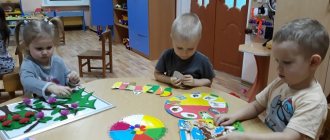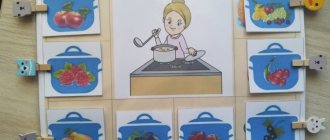Directing games in kindergarten are entertainment for preschoolers, in which the child independently develops an action plan, thinks through the game script, comes up with main and secondary characters, and gives them names. He chooses how the game will end and makes up the rules. The baby plays the role of each toy.
The game, which a child plays in the presence of experienced professional teachers, tells about his emotional state, level of intelligence and development, experiences and aspirations.
Age for directing exercises
The baby has been involved in directing games since birth. Every parent watched how children controlled dolls, which they gave names, built dialogues between them and created a thoughtful plot for the game. Children who have learned to walk take soft toys with them to bed, put them to bed, ride them on cars or take them for a walk.
Theatrical performances in kindergarten help teachers understand the family environment in which the child lives. If he creates conflicts during the game, then most likely the family situation is turbulent.
"Director's play, its features and significance for the development of a preschool child"
Director's play and its features
and importance for the development of a preschool child
Director's play is a special type of individual play, which is built by the child on two levels: for himself as a director and for a toy endowed with a specific role. The child comes up with a story, which he acts out with the help of dolls or other objects, acting and speaking for them. Director's play. promotes the development of speech, thinking, imagination.
K.N. Polivanova
The first game of a preschool child is director's play, which is a type of children's game and appears in the life of a preschooler after about two years.
This type of children's play is the least studied. Interest in it has arisen in the last decade. D.B. Elkonin called director's games a special type of individual child's play. Due to their originality, they are of particular interest for the psychology of children’s play, since it is in the director’s play that the child’s personal characteristics are revealed.
According to E. E. Kravtsova, director’s play in preschool age is not only the initial stage of game development, followed by figurative-role-playing, plot-role-playing and other types of games, but it (director’s play) completes the development of play in preschool age, collects the most important achievements of other types of games; it is in it, like a focal point, that all the features of the child’s imagination are manifested.
A preschooler's director's play is an individual game, during which the child creates play situations with toys and substitute objects. Of course, every child should be involved in group games, children should feel and understand other people, but this does not mean that there should not be individual games in kindergarten. Even the most sociable child periodically has the desire to make a building on his own or play with his favorite toy.
Pedagogical value of director's games:
– promotes the child’s social development, the ability to perceive and understand life situations, imagine relationships between people, their actions and deeds;
– help children gain gaming experience and thereby create the prerequisites for the transition to developed role-playing games;
– develop the child’s independence, the ability to occupy himself in a new life situation;
– help to acquire the skills and abilities necessary to organize independent theatrical activities;
– are a means of developing adequate self-esteem in a child - a necessary component of educational activity and an indicator of readiness for schooling;
– help children overcome communication difficulties, uncertainty, fearfulness, shyness, and isolation. This is the main accessible type of games for children raised in families and disabled children; children who have difficulty adapting to social forms of education;
– provide an opportunity to develop children’s individual characteristics and play creativity. Unfettered by gaming stereotypes and the demands of peers, the child departs from the learned model in constructing the plot. He independently models a new situation from elements of familiar plots.
Features of the director's game:
1. The child himself creates the plot of the game, which is based on the child’s personal experience. As a rule, the game reflects an event that made a lasting impression on the child (for example, a visit to a children's clinic, or a birthday celebration, or some kind of street incident). Very often, the plot of the game becomes the child’s knowledge obtained from cartoons, fairy tales, children’s programs or stories of other people. In the director's game, the child himself comes up with a script for his “performance”, i.e. is a director, he himself selects the performers of the roles and plays the roles for them.
2. Toys and objects that the child has chosen for play perform both direct and portable functions. In other words, very often in director’s games, children use so-called substitute objects. For example, a sofa cushion turns into a horse on which a child rides on a long journey, or a comb becomes a microphone for a doll that gives a concert on stage (in the role of which the sofa acts), etc.
3. The main component of the director's play is the child's speech. The baby enjoys expressively imitating adults. During play, a child’s speech may change in intonation, volume, tempo, and rhythm of statements. For example, a girl plays Kuzya the brownie and the hostess. The hostess baked pancakes and invited guests to her home. So, the girl spoke for Kuzya in a rougher voice, and for the hostess she spoke in a thin voice.
The speech can also be an announcer - text behind the scenes. For example: “Masha’s doll’s birthday” Mom said thank you for the gifts, the guests began to sit down at the table, etc.
Speech can be evaluative. For example: the guests are good, they brought me a lot of gifts.
4. As a rule, a children's director's play uses many characters, but the child acts with only 3–4 toys. For example, in the game “Concert”, a child places many toys that play the role of spectators, as well as artists, but he plays only with the active “artists” who perform; the rest of the toys take a passive position in the “auditorium”.
One excellent example of director's acting is given in the diaries of V.S. Mukhina. The child, having placed toys around him, lies quietly among them for about an hour, without touching them and without performing any external actions. When asked what he was doing, whether he was sick, he answered: “No. I'm playing." “How do you play?” “I look at them and wonder what’s happening to them.”
All of these are manifestations of the director’s play, which is not always noticed and correctly assessed by an outside observer.
The main task of the teacher
in the development of director's play - to guide children's play activities, enrich other types of play activities that contribute to the formation of director's play.
Pedagogical guidance during the game has its own characteristics:
it contributes to the development of its concept, expansion of content, clarification of game actions, roles, and the manifestation of friendly relations. The teacher must strive to ensure that these relationships are consolidated and become real relationships between children outside the game. In no case should management of the game be intrusive and cause preschoolers to protest and quit the game. Leading questions, advice, and recommendations are appropriate.
The teacher exerts an educational influence through the roles performed by children. For example, he asks a child who plays the role of a manager in a store game, where is the cash register, who is the cashier, why certain items are missing, is it convenient for the buyer to choose what he wants to buy, who will wrap the purchases, prompts that the buyers thank the seller, and the seller politely invites you to come to the store for shopping.
The most effective way of leadership is the participation of the teacher himself in the game. Through the role he performs and play actions, he influences the development of the content of the game, helps to include all children in it, especially timid, shy ones, awakens in them confidence in their abilities, and evokes a feeling of sympathy for them on the part of other children.
At the end of the game, the teacher notes the friendly actions of the children, the elders are involved in discussing the game, and emphasizes the positive relationships of its participants. All this contributes to the development of children’s interest in subsequent games.
The teacher must analyze the game, evaluate its educational impact on children and think about ways to further guide the role-playing games of the children in his group, instilling in them collective principles.
Advantages of the game:
– Director’s games allow the child to practice relationships and communication in the process of acting with dolls. Unlike a partner, dolls do not require a high level of communication from the child - it’s easier with them.
– When acting as a director, you don’t need to take into account your partner’s position, you don’t need to adapt to him. Here the child remains himself, he does not need to obey any general requirements, he comes up with his own rules and fulfills them himself, shows his creativity, his knowledge.
Scientists show that director's play is typical for children: those who do not attend preschool, those who are often ill, those with severe speech impediments, those who are withdrawn and inactive, and those who do not adapt well to preschool. Such children are prone to solitude, and the need for play is expressed through director's play.
Director's play manifests itself at the beginning of the 4th year of life. It is a prerequisite for a role-playing game. The game is based on personal experience. The plot is very poor. Children perform only well-known actions (feed the doll, put it to bed, wash it, etc.) Most often, children of the 2nd junior group have only two characters.
At the 5th year of life, the game is based on stories from fairy tales and cartoons, and the number of characters increases. Role-playing and evaluative statements appear in speech (cunning fox, evil wolf). At the age of 4-5, preschoolers begin a period of good role-playing play, but director's play remains widespread, because has the above advantages.
At an older age, there is a noticeable increase in gaming skills. Substitute objects are often used, the role of the toy is not fixed (for example, a dog can be both a lion and a monster), the plot is richer and more dynamic, and the child’s vocabulary is expanded and activated.
During the director's play, the child should under no circumstances be disturbed, pressure should be applied, the child should be compared with other children, his manifestations should be judged, or his feelings and emotions should be ignored. It is necessary to provide children with freedom and the opportunity to show inner activity. Therefore, it is necessary to create an individual space, provide them with space and time.
For the successful development of director's acting, it is necessary to create a number of conditions:
The first of these is the child’s individual space for play. Various screens will help to do this, both ready-made and made by parents; they can be in the form of a curtain, in the form of a folding book, flexible, and, if necessary, taking on different shapes. But the most favorite place for children to play individually are cardboard boxes.
The second necessary condition is that the child has small play material. Now on sale there are sets of small toys united by one theme (“Zoo”, “Pets”, “Army”, etc.). If it is not possible to purchase these sets, then you can make toys for director’s play yourself, using paper, glue and paints. Children will treat toys made together with their parents with more love and take care of them.
And finally, the third, most important condition for organizing a director’s game is skillful management of the development of this game. Adults help children find interesting activities. The tasks given by adults can serve as an impetus for directing; they develop and enrich the plot created by children. Often adults can be in the role of a spectator, but not a passive one, but one who is interested in what is happening, asks for clarification of certain actions, and emotionally responds to the events taking place in the game.
Fulfillment of all conditions will ensure the successful development of directing acting in preschool and family settings.
Thus, the skillful organization of director's play, the creation of the necessary conditions for its development, contribute to the acquisition of gaming skills by children, the formation of the child's personality, his social competence and the education of humanity.
The importance of director's games for preschoolers
The essence of director's games in a preschool institution (DOU) is the following goals:
- Teaching children free, open communication.
- Encouraging preschoolers to be the first to engage in dialogue.
- Teaching children to formulate sentences and express thoughts meaningfully and accurately.
- Teaching children to listen carefully to their interlocutor.
- Formulation of independence in preschoolers, the ability to make choices.
In preschool educational institutions there are usually decorations with the help of which children embody the scenario that they came up with on their own. Performances for preschoolers are important because in their absence, the child will not be able to fully socialize and become a full-fledged member of society.
Each preschool institution has a card index of theatrical games, with the help of which educators engage in the development of children.
Director's play
But let's return to the topic: how to teach a child to play
How is the game developing in general, what transformations is it undergoing? Many mothers say that there was a period in their baby’s life when mother’s favorite toys were pots, lids, and frying pans. Many of them get irritated: they are spinning under their feet. At first, the child simply manipulates the pots and pans. Then the first plot-based games appear - the child repeats the individual actions of the mother.
These display play activities are incredibly important because they create the basis for further development. And then the chain of games develops:
- director's
- role-playing,
- game with rules
- and again the director's.
Games for the younger group
Pupils of the junior group of a preschool institution are not able to implement the situation proposed by the teacher with the help of decorations. Therefore, give them freedom of action by first showing your own example of character control.
In the younger group, play the following games:
- Reproduction of the fairy tale "Kolobok". The task of teachers is to independently make characters out of paper or fabric. Get the kids interested by doing a demonstration. Recreate the fairy tale, voicing the characters believably, calling them by name and speaking in different voices. When you show the children the performance, invite them to play the same game. If you interest them, they will willingly improvise, giving the heroes other character traits.
- Game for the second younger group “Transformation”. Take a subject that the children know. Place the kids in a circle and pass the object to each person in turn. When it is in his hands, he must deal with the object in his own way. For example, a pen will become a screwdriver, a stick, a brush, a thermometer, a comb, a ball will become an apple, a stone or a kolobok, a book will become a chocolate bar, etc.
Preschoolers know how to improvise, but to do this they need the example of an older friend. Before involving children in the gameplay, show them how to play correctly by example.
Directing games in kindergarten
Olga Ageeva
Directing games in kindergarten
Directing games in kindergarten
Directing games in kindergarten must be organized for the following purposes:
• Teach children to communicate freely and easily enter into dialogue;
• Show what speech etiquette is;
• Teach children to speak expressively, meaningfully, and listen to their interlocutors;
• Show children what it means to “make decisions”
, creating artificial situations in which it is necessary to make a choice.
To conduct director's games, special attributes are needed - heroes and scenery, with the help of which the child can reproduce the situation he has invented. The teacher can only give him a topic, prompting him at some points. The best director's game in the senior group is a puppet theater, in which the child can give free rein to his imagination and show a real performance to all his classmates. Features of director's games in kindergarten
Games for children of different ages have their own characteristics.
The director's play in the younger group has a very simple plot. All actions are performed on one character, who is fed, bathed, dressed, taken for a walk, etc.
As you gain skills, the games become more difficult . And the director's acting in the middle group is already very diverse. There are more heroes. And the plot is based on a fairy tale familiar to the child or a cartoon he watched the other day. Value judgments appear - an angry wolf, a cowardly bunny, etc.
In addition to role-playing games, the child begins to master plot and role-playing games. That is, other children can already take part in the game.
The director's play of children in the older group acquires greater dynamics. Children use substitute objects more often. Thus, one toy can be endowed with different qualities and perform completely different roles.
Director's games do not lose their relevance in the preparatory group either. While playing, kids continue to improve their skills with pleasure and experience happiness from creativity.
Directing games in a preschool educational institution (preschool educational institution)
help the comprehensive development of the child and contribute to the full development of the individual.
Director's play in the younger group
Small children aged 2-3 years are not always able to independently play games . You should not impose your plot on them, but first, the teacher should show a clear example, explaining how to play, control the characters and come up with scenarios.
Director's play "Kolobok"
An excellent visual example of a director's game in a younger group can be the reproduction of a fairy tale. As an example, you can take the simple Russian folk tale “Kolobok”
, which will probably be known to every child in the group. To begin, prepare the dolls of the main characters of the fairy tale yourself. If you don’t have dolls, then you can make all the characters out of paper, create an impromptu theater and control how the plot will unfold in it. It is important that Kolobok, Baba, Grandfather, Fox, Wolf and Bear each have their own character; convey their mood with voice, breathing, and other sounds so that they can come to life in the imagination of your little viewers.
Try to completely reproduce the entire plot of the fairy tale, and in the final part, summarize by telling what this fairy tale taught the children. By holding such a demonstration performance, you will clearly make it clear what a director's game , this will certainly interest the children and they will begin to improvise. A wonderful director's game in the middle group, this is a game of "Family"
, during which the teacher will be able to find out what role the child gives to the family in his life, how he feels in it.
Directing games in professional preschool educational institutions
Director's games in professional preschool educational institutions are the best opportunity to tell children about different professions, to make it clear that “all professions are needed - all professions are important!”
.
It is best to conduct such director's games in a preparatory group; the theme can be games of doctors , teachers, gardeners, cooks, etc. A
properly organized director's game helps to talk about many new and unknown things, develop children's imagination and thinking, which is very important at all stages growing up.
Director's play is a type of story game , the specificity of which is that the child organizes the activity as if from the outside, like a director , building and developing the plot, controlling toys and voicing them. From a psychological point of view, directing is “imagination in action”
(E. E. Kravtsova)
.
D. B. Elkonin called director's games a special type of individual child's play . Due to their originality, they are of particular interest for the psychology of children's play , since it is in the director's play that the child's personal characteristics are revealed.
“ The director’s play seems to be an alloy in which the social and the individual appear in a dialectical interweaving and are accessible to observation and control.” 's play has exceptional possibilities in terms of its use for diagnostics with the aim of subsequent correction of the personal development of children. (Gasparova E. M. 1989)
.
The director's play indicates that the child is actively appropriating culture, reflecting what is of paramount value to him. By creating and voicing the objective world, the child embodies his own ideas, his own vision of the surrounding reality. Therefore, director’s play is the most important factor in the socialization of a preschooler and, at the same time, one of the few means that allows an adult to find out what the child’s value orientations are, what excites and interests him.
The child, like the director, imagines how different characters will interact and what will happen as a result of this. He looks at imaginary events and evaluates them from different positions. Having learned to act from different points of view in director's play , the child more easily masters communication with peers as an activity of value in itself.
The object world of director's play is extremely diverse: these include toys and various objects to which the child transfers the functions of those toys that are not enough to implement the plot. This indicates that in director's play the child masters the ability to transfer functions from one object to another, a substitution mechanism appears, thanks to which the formation of genuine play - symbolic activity - occurs.
Games for the middle group
Preschoolers 4–5 years old already know the properties of surrounding objects, they know fairy tales, and they are aware of the consequences of some of their actions. Games suitable for them:
- Act out the plot of the fairy tale “Masha and the Bear”. Choose children who are suitable for the role of Masha, the bear, introduce secondary roles: bunny, hedgehog, etc. Children will improvise, since the fairy tale is already familiar to them, but teachers must motivate them. Dress the kids in appropriate costumes and tell the plot of the fairy tale during the game so that the kids don’t get confused. You act as the leader.
- Play with the guys, sitting in a circle. Ask to imagine yourself as a bunny (or other character) and tell about yourself. Do this with each child in the group.
With the help of such exercises, children in the middle group will learn to combine words and actions, work in a team and formulate thoughts when conducting a dialogue.
Games for older children
Games for older preschoolers teach children not only to speak like the characters, but also to feel their emotions. Children realize that they must believably portray the character entrusted to them.
Theatrical games for the senior group:
- Ask the guys to split up into pairs. Give one child in a pair a magic wand (any suitable object). Let him ask a friend: “What can I do to make you feel good?” and touches it with a magic wand. He answers what he would like. For example: “Dance” or “Sing.” Here kids have unlimited choice. Later the guys change roles.
- Divide the children into 2 teams. One team will portray animals. Each kid must move, scream and act like a zoo animal, while the second group will walk around the makeshift zoo and take pictures of the animals. Later the teams switch roles.
- Draw a strip no more than 40 cm wide on the floor or asphalt. Explain to the children that this is a bridge that they need to cross so as not to fall into a deep ravine. Two people can walk on the bridge from different sides to prevent it from overturning. The guys independently agree on the pace at which they walk and carefully pass each other in the middle of the bridge.
Older preschoolers learn to negotiate among themselves with the help of director's productions, interact and find a compromise.
How does a baby learn to play?
Substitute items
How to find out whether a child has his first director's play or not? Take a closer look: if a child, instead of a phone, picks up a brick and, putting it to his ear, says something, or moves the brick around the table, making the sounds of a running motor, or does something else similar, this is great.
You are watching the first game actions of the director's game. They differ from simple manipulations with toys in that the baby transfers functions from one object to another. As teachers say, he begins to use substitute objects. Rejoice, you are being shown the first manifestations of imagination - the highest of the highest mental functions.
Director's play appears in three-year-old children and is characterized by the primitiveness of the plot and short duration. But don’t let this bother you, hard trouble is the beginning.
Fairy tale
Fairy tales acquire special significance in teaching a child how to play. They are especially important for the first director's games. A director's game always has a plot (that's why it's a game). It is difficult for a small child to come up with it on his own. A fairy tale or cartoon helps him.
The child does not listen to fairy tales. This also happens. Therefore, tell them using puppet theater. You can see what they are in the video here. When a word at three years old (and older) is based on some image (picture, object), it is perceived as if at a higher level, because both hemispheres of the brain are involved in the work.
A fairy-tale plot-scenario helps the child learn to come up with mise-en-scène - to imagine a sequence of actions in space, in other words. At first, the director's play will be based on the fairy tale verbatim. But over time, the baby will learn to overcome this given plot. Let me give you an example of an already quite developed director’s acting.
Games for preparatory group
The children who will soon go to school already know and know a lot. Games for them are aimed at strengthening social skills and learning to communicate with adults. They are a continuation of the director's games of the older group. In the preparatory group, play the following games with your children:
- The teacher connects the right palm with the child’s left palm, and the left palm with the baby’s right palm. In this position, the couple avoids obstacles in the room. Obstacles include tables, chairs, pillows, etc.
- Ask the children to draw a picture that embodies the plot of their favorite fairy tale. After this, the child tells what he drew and explains the story that he captured in the drawing.
- Watch a cartoon with the guys that lasts up to 5 minutes. Prepare costumes and other props in advance. After watching, invite the children to play the cartoon. Assign roles between them, dress them in costumes and give the children the opportunity to improvise.
Conditions for successful production
To interest preschoolers, you need to:
- Give them positive impressions about life.
- Create comfortable conditions by providing props and costumes.
- Give the guys time to improvise.
- Show an example of an interesting production.
Teachers are not only presenters, they provide complete guidance over children’s games so that children do not enter into conflict situations.
The purpose of the exercises is to teach children to live among people in comfort, and not in tension. Properly implemented performances develop the child as a strong personality. Previous articlePreviousNext articleNext






